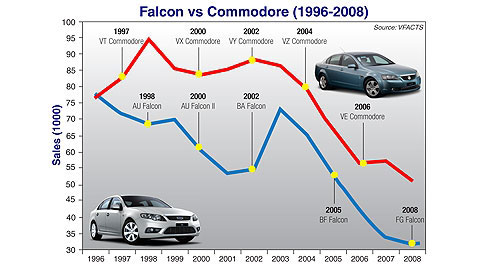Make / Model Search
News - General NewsBattle of the heavyweightsHead to head: One of the most enduring battles in the Aussie automotive market has been the Falcon-Commodore duel. How Commodore and Falcon have gone down slugging21 Sep 2009 HOLDEN has thrown the latest punch in the Commodore-versus-Ford Falcon battle, one of the fiercest rivalries in the automotive world, with two more efficient and more powerful V6 engines. Crucial to the success of the respective companies, the big family sedans symbols of Australian transport as well as a representation of our ever-advancing capability to produce world-class cars at an affordable price. They have rubbed doors and bumpers for decades at race tracks around Australia, but the real battle has been in the showrooms. Both have been battered by sliding fleet sales and increased competition from imported models, but no matter how much the volume has decreased, the teams at Ford and Holden still desperately want to beat each other. Holden’s Commodore is again leading so far this year – 28,772 to 19,776 to the end of August, according to VFACTS sales figures. Ford insists that if you exclude wagon sales, the Falcon and Commodore are neck and neck. This might be true, but VFACTS doesn’t distinguish between wagon and sedan.  Left: Ford Falcon AU Forte. Below: Holden Commodore VT. Left: Ford Falcon AU Forte. Below: Holden Commodore VT.Besides, Holden invested heavily in its Sportwagon, while Ford simply fiddled around the edges with its BFIII wagon. Sales figures reflect the outcome of these two policies. Holden is looking to capitalise on its new 3.0-litre V6, which for the first time in a long gives it a fuel-economy advantage. Ford will continue to improve its fuel efficiency of its existing 4.0-litre six, including an important step forward to meet Euro 4 emissions next year when it will also adopt leading LPG technology before introducing a four-cylinder engine in 2011. It is impossible to predict if the Falcon will overhaul the Commodore in the next few years. There would be one hell of a party in Campellfield if it does. Our graph shows the Commodore’s recent dominance in detail through the late 1990s to the present, but it was not always the champion. Ford’s masculine XD and XE Falcons (1979-1984) gave Falcon the edge over the smaller VB and VC Commodore, but Holden hit back and the two cars swapped leadership through late 1980s and the early 1990s. The smooth looking EF and EL Falcons (94-98) saw Falcon hit the lead again in the happy days before the VT Commodore arrived. The 1996 tally read Falcon 77,835, Commodore 76,849. It should be noted the Commodore figure actually included sales of the Toyota Lexcen (which it produced in part of a short-lived car swapping scheme which ended that year) but the numbers were minor, to say the least. It was the last time the Falcon would outsell the Commodore on an annual basis to this day. Four letters give us an insight into what went wrong for Ford in 1997 and 1998. VT and AU. The VT Commodore was a raging success. Customers loved the rounded, jelly-mould shape above all, which is attractive to this day. The 1998 AU Falcon was an instant disaster. Seven years later, Mercedes-Benz would prove some elements of the design could work if executed properly when it presented the CLS, but it was not right for the average Australian in 1998. The company also let itself down with cost cutting measures that were not missed by customers. They voted with their feet and AU Falcon sales dropped to 68,758 in 1998, while the VT Commodore was almost as popular as Elvis, with 94,642 sales in the same year. Ford has not yet recovered from the AU failure, remaining haunted by poor resale values and lost loyalty as the Commodore has held sway. The brilliant twin-cam BA saw Falcon sales surge back to 73,220, but it would be the last time the Falcon broke through the 70,000 barrier. From 2004, both models have struggled. The VE Commodore of 2006 led to a small recovery the following year, but suffered another drop in 2008. Ford’s FG Falcon also failed to stem its sliding sales in 2008. This year, some positive signs are starting to appear. Holden’s number of 28,772 Commodores sold to the end of August is down 12.9 per cent on the same period last year and Ford’s of 19,776 Falcons is down by 5.5 per cent. But these numbers can be viewed positively because the overall new car market is down by 14.2 per cent for the same period. From Holden’s perspective, it is expecting a big kick from its updated VE from this month. Crucial to the success of both cars is how they capture the fleet market in the next few years. Both have been hurt by ‘no six-cylinder’ policies introduced by several government departments and companies. Ford’s answer will be the four-cylinder EcoBoost engine from 2011, while Holden, for now, is hoping to convince fleets to accept a smaller six-cylinder. Recently departed GM Holden chairman and CEO Mark Reuss lit a fire just before he left for Detroit by saying Holden, with its Commodore, would out-engineer its competition (ie the Falcon). That prompted a quick response from Ford Australia president Marin Burela, who poured scorn on the comments and said it filled him with delight “because we know what we have coming”. The Falcon and Commodore might be fighting for a reduced share of the market, but the battle is just as fierce as ever.  |
Click to shareGeneral News articlesResearch General News Motor industry news |









Facebook Twitter Instagram